2020 was a difficult year for the world to cope with. The climate changes, civil unrest, political upheaval and a pandemic made the ending of the second decade of the twenty first century a mark to reflect on all that went wrong. India witnessed many socio-political disagreements this year, but it also emerged as the year of the dawn of a fourth wave of feminism.
Women took to streets and held placards proclaiming their demands and expectations from the structurally patriarchal system we live in. From campus protests to challenging parliamentary Bills, women did not rely on their male counterparts to do the talking for them. This year began with the image of women students standing atop cars and screaming how they wanted to be heard and ended with thousands of women sitting on roads demanding protection of their lands. This listicle is a comprehensive flashback of the feminist moments that shaped the socio-political dialogue this year and shattered stereotypes.
1. Smash The Patriarchy
On September 8 this year, Rhea Chakraborty appeared at the NCB office for questioning wearing a casual t-shirt that had a quote printed on it. “Roses are red, violets are blue, let’s smash the patriarchy, me and you,” that shook social media and waged a war on the very idea of patriarchy. Though the sides were well drawn, it at least sparked a debate on the much-needed topic. The witch hunt against Rhea was the most brutal form of media trial Indian had ever witnessed.
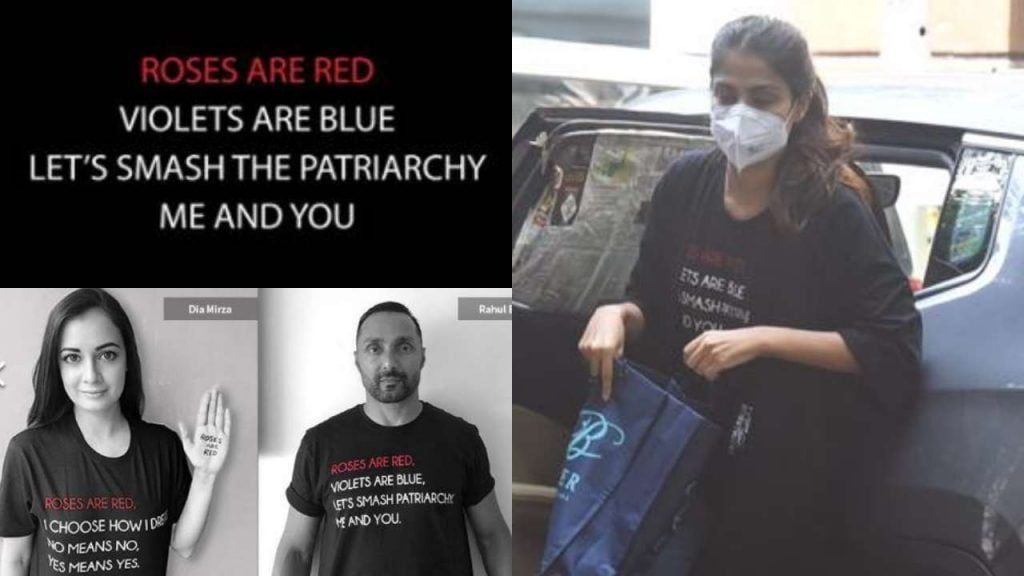
From a conniving bi*** to kaala jaadu to a gold digger to a promiscuous witch, she was labelled names that the patriarchal stereotypes had taught the testosterone driven media houses. While the trial was something nobody interfered in, Bollywood was quick to take to their social media to stand in solidarity with Rhea. She was scrutinised over her demeanour and the way she walked to the clothes she wore and the statements it enunciated. The T-shirt could have been an innocent pick by the young actress, the statement it made will always stay etched in the pages of history of Indian feminism.
The statement “smash the patriarchy” was made by Rhea but it soon involved other feminists from the industry calling the long-naturalised patriarchy in Bollywood. While Swara Bhaskar tweeted a collage of photographs of Sanjay Dutt, Salman Khan and Rhea Chakraborty, all leaving offices of legal authorities and questioned if the difference in treatment were not evident of the patriarchy enough, Sona Mahapatra took to twitter to recommend 10 changes in Bollywood, if it were ever serious about ‘Smashing the patriarchy.’
Her recommendations demanded equal pay, worthy roles, un-objectified song presence, speaking up for colleagues, being more inclusive for film technicians, giving equal importance to female singers, being ashamed of the institutional sexism, trusting and investing in women directors, putting a stop to promoting unhealthy age gap between the 50 something actors and 20 something actresses and encouraging casting older actresses. ‘Smash the patriarchy’ was a statement that shook the foundations of patriarchy in India in the crevices that hide it well like Bollywood and the media industry. A T-shirt slogan was all it required to unveil the ugliness!
2. Bilkis Dadi as Part of Time’s 100 Most Influential Person
The anti-CAA (Citizenship Amendment Act) protests of 2019-2020 shifted the center of power in a nation that has been habitual of placing the power at the hands of a male political center. The protests, dominated by women sitting in the chilly winters of Delhi’s Shaheen Bagh became an image of Indian feminism that the world was in awe of. In September this year, the movement was lauded by the inclusion of 82-year-old Bilkis Dadi in the Time’s list of 100 of the World’s Most Influential People.
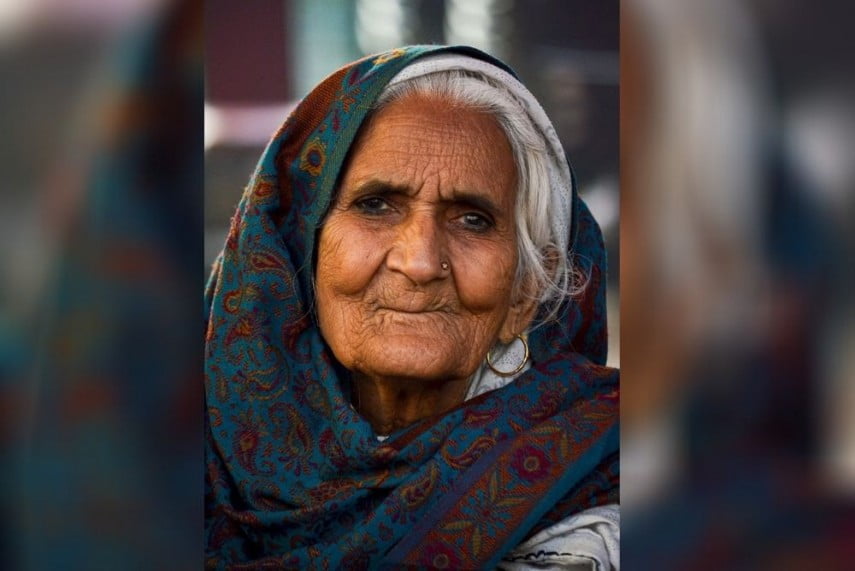
Her wrinkled face and lean frame became the face of Anti-CAA protests nationwide. She was resolute about her demands from the political overlords. She taught how a woman can not only pioneer a protest but also shake the foundations of government. She fought against the threat to her citizenship and majoritarian laws. Her voice resonated as the call for intersectional feminism that demands an equal right of citizenship for the minority of the nation.
Dadi sat at the protest site from 8 a.m. every morning till midnight, eloquently stating her demands. She emerged as the icon of women’s participation in social movements that decide the fate of a nation. She broke the boundaries of home and took to the streets to protest against what she believed was draconian, all while radiantly smiling. She became the reason for young girls to protest for their political rights and understand the importance of protesting in a democracy.
Also read: 7 Feminist Films Of 2020 That You Can Watch Online
3. Women breaking stereotypes in Defence Forces
2020 would be remembered in the year of Feminist Movements as a year that shattered all stereotypes. The very beginning of this year witnessed a 26-year-old woman leading an all-male contingent on Army Day and the Republic Day parade. Indian Army Captain Tania Shergill became India’s 1st woman officer as Parade Adjutant at the Republic Day Parade 2020. The spectacle of a young and confident woman leading the contingent was a proud moment for every Indian applauding the new dawn of feminism in India. 2020 was also a year that stood witness to the implementation of a landmark Supreme Court judgement that granted permanent commission to women in Indian Army.

By November this year, 450 women officers had gotten Permanent Commission as remarked by Justice Chandrachud. Another moment that marked feminist pride was when Varanasi’s Shivangi Singh was chosen to be the first woman pilot to fly Rafale. Rafale jets stayed in the political conscience of the nation as a tug-of-war of military power. It made news immediately when the young pilot was training in Ambala to soon join the “Golden Arrows”, a squadron being prepared to fly Rafale jets.
4. Women in Farmers’ Protest
Farmers Protest in India is amongst the biggest protests ever documented worldwide. While the history of protests has witnessed men holding down the fort as conscious pall bearers of legal and political decision-making, India taught the world a contrasting image. Women in Farmers protest have been vocal and active. They have stood out as they speak their minds without any political fear and understand the economics of their home and land better than their male counterparts.
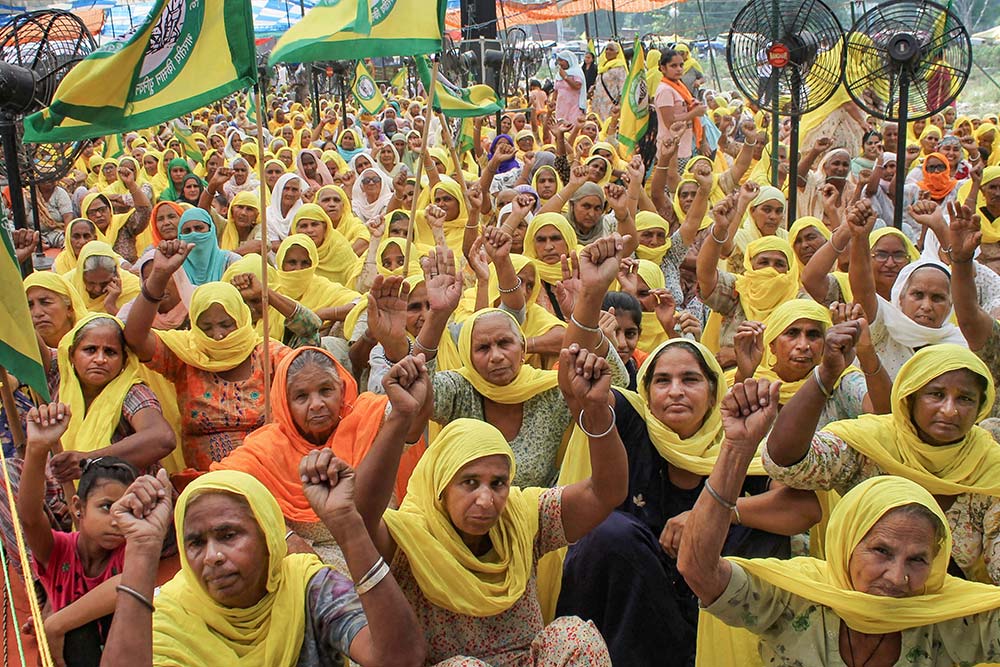
Thousands of women have walked to Delhi and thousands other have occupied posts back in Punjab and Haryana to keep the protests alive. Women have been breaking their ‘domestic’ image by eloquently explaining the innuendoes of the Farmer Laws forced on them. They sit at the protest vocalising their demands and not just cooking or flipping rotis. The very spectacle of thousands of women singing and protesting and interacting with the media has changed the way the Urban Intellectual India perceived a farmer woman. Women have their own union wings, and are the leaders and treasurers of many other.
Women have also flocked to demand justice for their husbands and sons who committed suicide under immense financial pressure. Harinder Bindu, a young farmer from Bathinda reached Delhi leading a convoy of over 10,000 women coming from 14 districts of Punjab. She voices her demands sitting on the roads of Delhi clearly stating the legal innuendos of them. She believes it’s important for women to fight for their rights because they would be affected differently, as they already bear the worst of poverty. She says it will ultimately be the women who will have to cut their meals to feed the family. Women at the protest are riding a fourth-wave of feminism in India that will write the saga of a more equal decade to come.
5. Sania Mirza’s comeback
Returning to Tennis in January 2020, after two years of maternity break, Sania Mirza redrafted the Fairy-tale comeback stories of sports. She won the double titles in her first tournament, the WTA Hobart International, partnering with Nadiia Kichenok of Ukraine. The 33-year-old was at her highest, guiding India to a historic maiden Fed Cup playoffs spot in Dubai in March, just when COVID struck. Mirza’s comeback is not only a success story for her fans, but a moment of pride for the feminists of this country.
For a country like India that still deals with motherhood through a prejudiced lens, Mirza’s comeback has proven that being a mother could be a motivation rather than a hindrance in the career of a woman. All eyes are set for her revival in the game once the pandemic is over.
6. Anti-CAA protests
The anti-CAA (Citizenship Amendment Act) protests of 2020 shifted the center of power in a nation that has been habitual of placing the power at the hands of a male political center. The protests, dominated by women sitting in the chilly winters of Delhi’s Shaheen Bagh became an image of Indian feminism that the world was in awe of. The call for the right to citizenship by the minority reverberated through the foundation of this country’s law-making bodies. The anti-CAA protests brought together students from reputed Indian universities on streets demanding their right to remain Indian citizens without having to furnish documents as proof of their nationality. Women from the margins of the margin then took it on them to protest on the streets from the dawn to dusk, in solidarity with their children.
The non-violent protests across the nation were spearheaded by women, making it into a movement that would shape the existence of minority women in the decades to come. The inclusion of Bilkis Bano’s (Dadi) name in TIME Magazine’s Most Influential People’s list is a testament of the conviction with which these women fought for their right to their national identity.
7. Dalit Lives Matter protests following Hathras rape incident
September 14 2020 witnessed the gangrape of a 19-year-old Dalit girl from Hathras, Uttar Pradesh. The aftermath of the brutal incident was a shocking awakening for the nation. The girl died of brutal wounds and medical negligence two weeks later in a Delhi hospital and the police authorities burned her body in the dark of nightfall without the consent of her family. Not only was this a gross violation of legal ethics but also the humane right to a dignified death. The incident sparked protests across nation and photographs with students holding placards claiming Dalit Lives Matter soon attracted national and international attention. The callousness with which protestors were scattered away and the family of the victim was locked in their own home became a spectacle of violation of human rights. The rape and the systematic authoritarian intervention to dismiss the allegation uncovered the rotten reality of a nation diseased with patriarchy and casteism. The protests that followed were a realisation for intersectional feminism in our country and the need for all to unite in the cause for protecting the margins.
8. The Problematic Transgender Persons (Protection of Rights) Act, 2019
Transgender Persons (Protection of Rights) Act, 2019 was passed last year in the parliament amidst Opposition’s uproar and criticism from the Trans community and LGBTQIA+ activists because of several problematic clauses. Not only did the government attempt to rush the draft rules by only giving a month’s time for feedback and suggestions, it also violated NALSA’s verdict of the right to self-determination. Critiques maintained that the Act would take away agency from transgender people rather than enabling them.
The Ministry of Social Justice and Empowerment issued the draft of the Transgender Persons (Protection of Rights) Rules, 2020 in July this year and welcomed suggestions and objections. The revised version of the Bill repealed the clause of medical examination by the District Magistrate to affirm the identity of a transgender person. The lack of clarity within the Act shows in how it has tried to club the different gender identities under the ambit of ‘transgender’ and thus, explicitly invisibilising intersex persons and non-binary persons and the issues pertaining to them, such as the surgeries conducted on the bodies of babies to ‘rectify’ genitalia.
This moment from 2020 is historically significant in how the law and policy-makers of the country framing guidelines that would deeply affect the lives of marginalised communities showed an utter lack of knowledge and understanding of the communities that would be affected.
9. Durga idol in Kolkata pays tribute to Migrant Workers
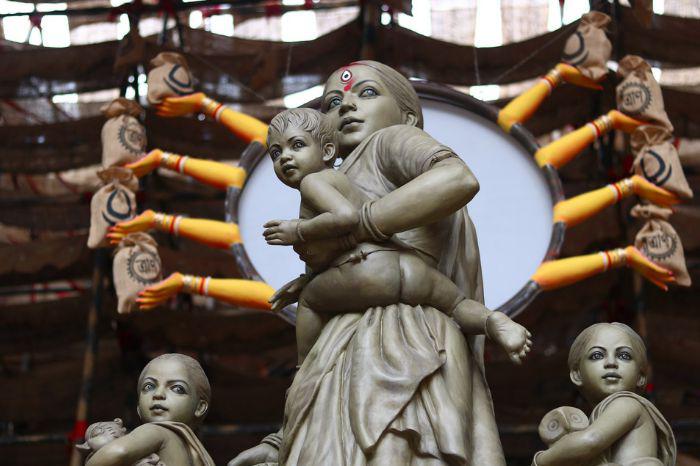
This year’s Durga Puja witnessed an idol of a migrant woman being raised to the stature of Durga Maa, holding a child in her arms. The Durga idol of Kolkata’s Barisha Club was a tribute to all the women who marched to their homes barefoot, holding their children and their luggage. The list of feminist moments would be incomplete without the mention of the idol that celebrated womanhood in its most raw. The idol was trailed by two daughters, depicting Lakshmi and Saraswati with one holding an owl and the other caressing a swan.
The fourth child giving them company was a pot-bellied Ganesha, depicting the strength of divinity in the migrant labourers who walked towards their home. The idol tells the tale of feminist strength and perseverance and must be preserved for the generations to witness the strong feminist message of 2020, a year fighting the pandemic
Also read: 10 Feminist Judgments Of 2020 That We Are Proud Of
Disclaimer: This article has been edited to reflect the Anti-CAA and Hathras case protests. This list is not exhaustive and suggestions are welcome in the comments box below.
About the author(s)
Dr. Guni Vats is an Assistant Professor at the Department of English, Manav Rachna International Institute of Research and Studies. A PhD in Gender Studies, she is a renowned researcher, writer, and scholar.
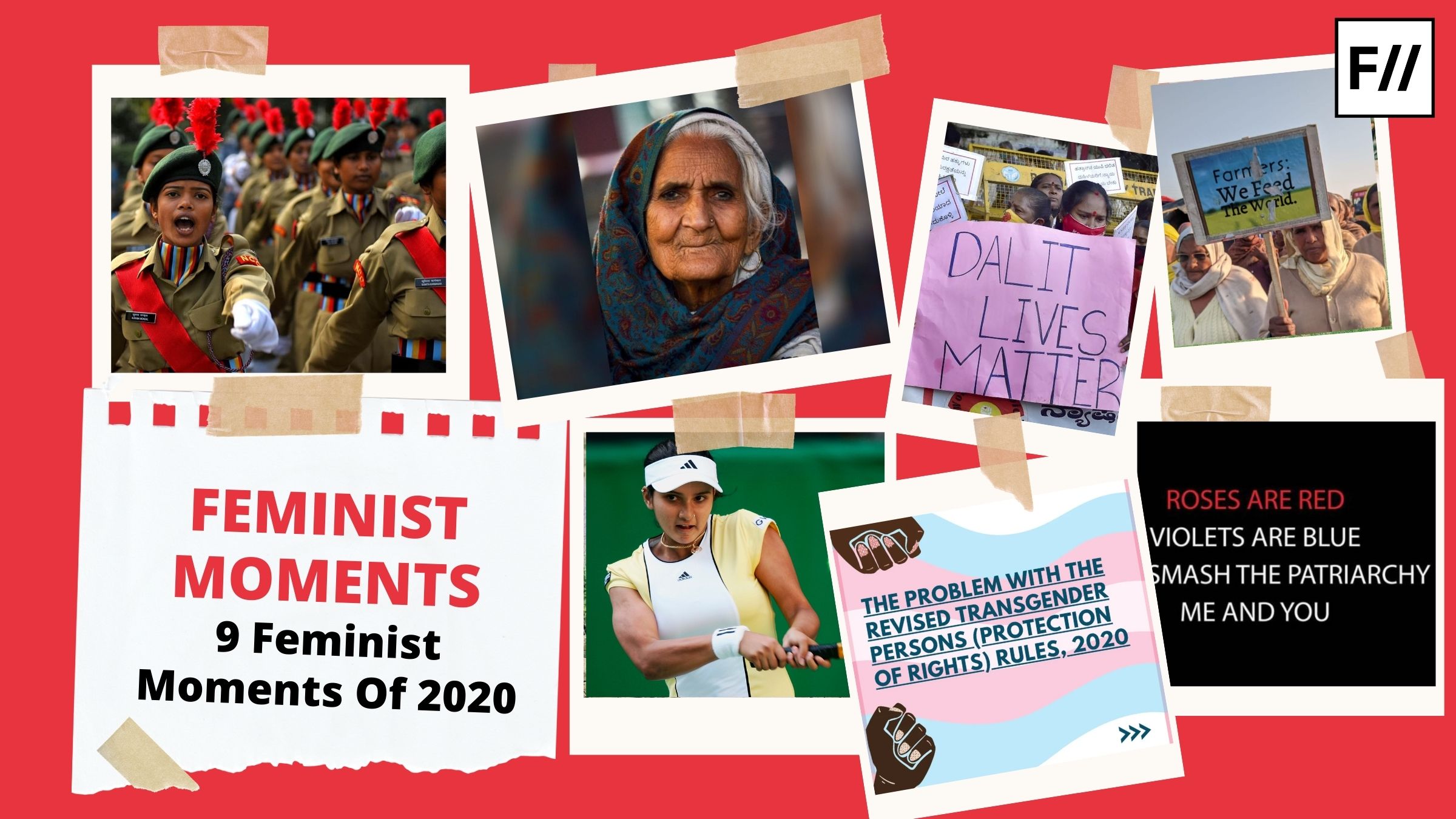



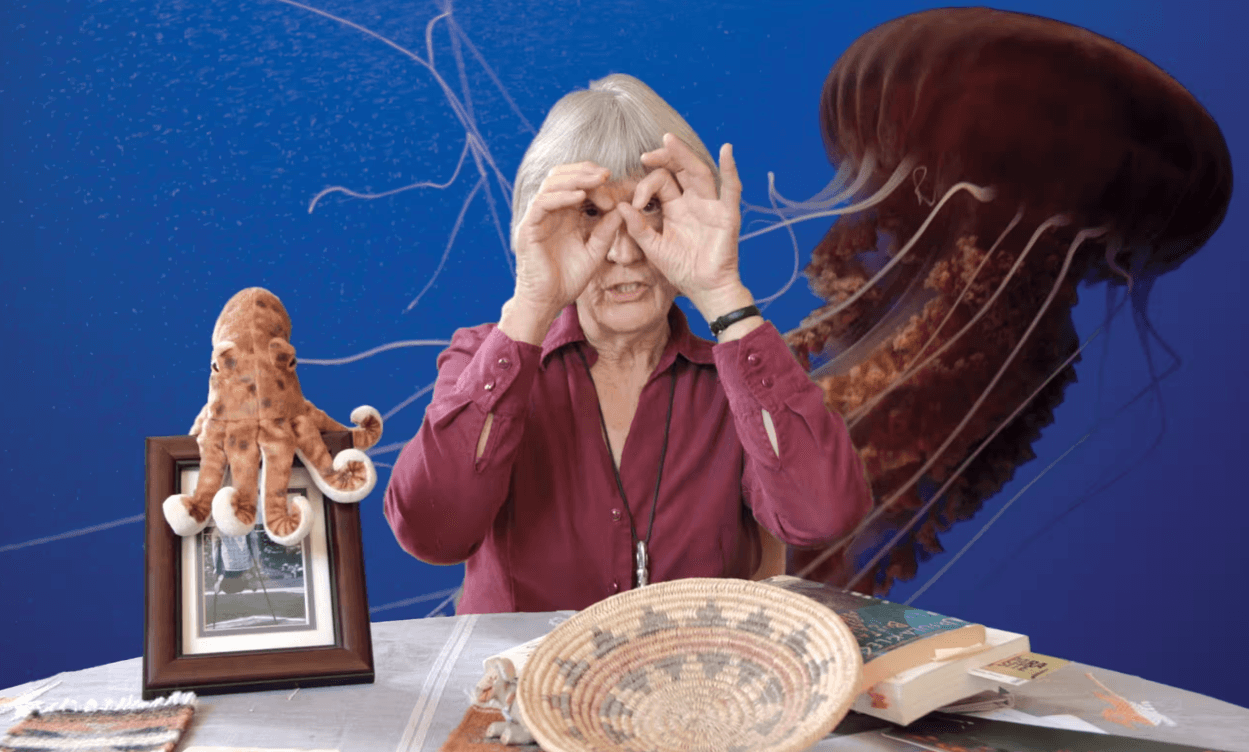


It is certainly an interesting brand of feminism to include both the CAA protests and inclusion of women in the army as feminist moments. One is a liberating feminism ans and the other exists explicitly for colonization and violence that directly strips women of their agency. So definitely feel as though the author needs to perhaps realign their orientation of feminism. There is no such thing as objective or neutral feminism.